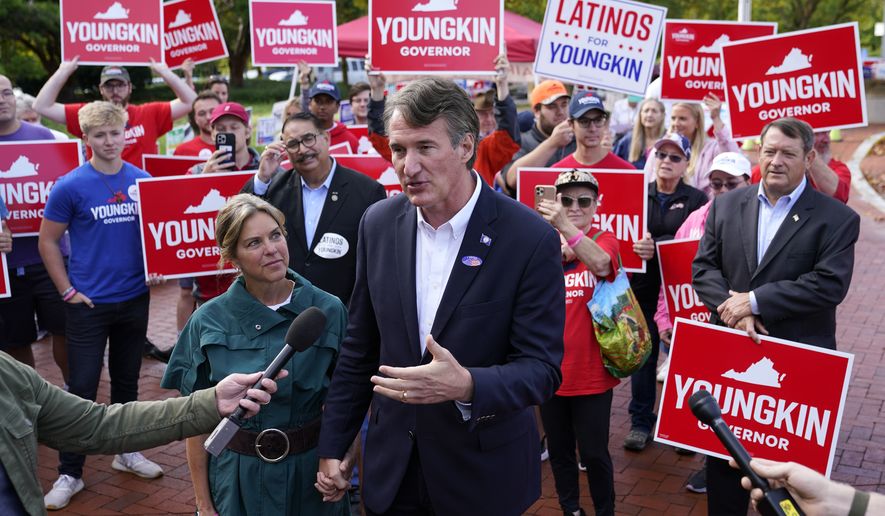
In the 2020 presidential election, President Joe Biden triumphed over then-President Donald Trump in Virginia with a decisive ten-point victory. Looking at how Democrats have won the state in the past four presidential elections and won every Senate race in the state since 2006, pundits began describing Virginia as a “deep blue” state — joining states like New Mexico, Maine, New Hampshire, and Colorado, all of which Biden won by similar margins.
Just a year later, the story is being flipped on its head. Glenn Youngkin, a Republican businessman, bested former Governor Terry McAuliffe by two points, marking an astounding twelve point shift to the right from the 2020 election. Losses in the gubernatorial race, the lieutenant gubernatorial race, the attorney-general’s race, and the House of Delegates have rightfully been declared a major warning sign for the Democratic party ahead of the 2022 midterms.
In the analysis of the election, much attention has been paid to Youngkin’s campaign strategy — how he brought together Trump’s core MAGA base and suburban swing voters disillusioned with Trumpian politics to put together a winning coalition — but the Democrats must look inwards in analyzing the results and in preparing for the future. Youngkin’s campaign was undeniably well-run, focusing on a key message of education and “parental rights” while distancing himself from the lie of Trump victory in 2020. But the Democratic Party must be able to hold its own against candidates who run good campaigns. The party can’t rely on only running against controversial, conspiracy-backing candidates.
There are a few key lessons to be gleaned when looking back on Terry McAuliffe’s failed campaign. Chief among them is the ineffectiveness of running campaigns against Trump when Trump isn’t on the ballot. McAuliffe, throughout the election, continuously tried to tie Youngkin directly to Trump — in one case mentioning Trump’s name thirteen times in a fifteen minute speech. In McAuliffe’s final rally on November 1, he fully invented a Youngkin-Trump joint rally, saying that Youngkin was finishing his campaign with an event alongside the former president. In reality, Youngkin was doing his own independent event elsewhere in the state, actually speaking on the hot issues affecting voters.
This is not to say that the Democrats should fully abandon attacks on Trump — especially as he, and his loyal cadre of Republican supporters, continue to chip away at the democratic system — but rather this proves that emphasizing a link between a Republican candidate and Trump is only effective if the candidate actually fully embraces Trump. Against the Marjorie Taylor Greenes and Matt Gaetzs of the GOP, tying their own controversial and offensive comments and actions to the former President’s own controversial and offensive comments and actions can be effective, as seen in 2020, and is necessary. But in a case like the Virginia gubernatorial election, where the candidate is toeing a (comparatively) moderate line and in fact actively held the former President at arm’s length, the message fails. When your opponent is hammering on key concerns for massive swathes of key voters, in Virginia namely the suburbs, through talking about education and parental choice in education, and your only response is to say “hey, Trump likes this guy,” it comes across as a non-answer — an excuse that validates your opponent’s message.
Moreover, speaking solely about why the Republicans are bad and would be bad in governing is considerably less effective when your party is in power. In 2020, it made perfect sense to exploit every single offensive comment, stupid action, bad policy, and dangerous instance of governmental overreach that the Trump administration made in the past four years — they were the ones governing, and they failed. But now the Democrats have a trifecta in the federal government, and in Virginia have controlled both houses of the legislature and the executive branch since 2019. Voters rightfully want to know what you’ve done in power, not how bad the other guy would be if he was in power.
McAuliffe had a substantial amount of things he could have emphasized more about himself, namely concerning his previous stint as Governor. He could have focused on the amount of new capital investment brought in during his term and the overall success of the Virginian economy during his tenure — both counterarguments to Youngkin’s twenty-five years as a businessman. Centering his campaign on his relatively popular term as Governor rather than the downside of a man who wasn’t even running in the race could have been a strong strategy indeed.
Yet the fault cannot all be put on McAuliffe’s shoulders — there is plenty to go around with the Democratic party as a whole. Namely, McAuliffe had minimal actual help from federal Democrats in the Capitol. With both the bipartisan infrastructure bill and the Build Back Better Act stalled due to Democratic infighting as of the time of the Virginian election, McAuliffe had very little to bring back in terms of what the Democrats have done with power since Virginian voters helped oust Trump. Simply put, getting things done on a national level is the easiest way to give down-ballot Democrats something to run on — something to point at and say “see, this is what we’ll do to help you if you vote for us.” Instead, McAuliffe was handed headline after headline of Democratic infighting and dysfunctionality, which is hardly easy to capitalize on when campaigning.
Thankfully, there are signs that the national Democratic party has picked up on the latter point. In the two weeks since the election, the bipartisan infrastructure bill has been signed into law, authorizing billions in infrastructure spending, and the House voted to pass on the Build Back Better Act to the Senate. One can only hope that this surge of productiveness doesn’t peter out back to the gridlock of the months prior, and that into 2022 — closer to the midterms — the Democrats continue to pass things that they can run on proactively. That, combined with reorienting messaging away from a Trump-centric point of view and to a more issue-centric point of view, may put the Democrats on a better footing going into the inevitably rough midterms.



